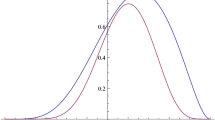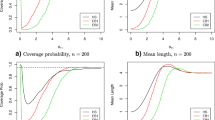Abstract
In the present paper it will be argued that if a parameter value assigns zero probability to an open set containing the actual response, then that parameter value should be excluded from the parameter space. When this is done, the model becomes a restricted model, and sampling theory inferences should be focused on the sampling distribution of an hypothetical independent response from the restricted model.
The above situation may arise when probability densities vanish outside a compact set. This phenomenon arises frequently in the real world, but it is usually ignored for reasons of mathematical convenience. Although many statistical procedures remain substantially the same when we consider this restricted model, admissibility propertics may be drastically changed, and inferences which are known to be inadmissible may turn out to be really admissible. Thus, Stein's phenomenon concerning the inadmissibility of the sample mean as an estimator of the population mean of ap-variate normal distribution whenp≥3may be explained by the fact that the distribution has a compact support but this has been ignored by reasons of mathematical convenience.
The introduction of a restricted model is also important in the study of coherence. Thus, it will be shown that Brunk's theory of countably additive coherence, which admits the use of countably additive improper priors, can be improved with the introduction of a restricted model. Thus, the theory will be unified because it will be proved that the posterior is really coherent if and only if it is a Bayes posterior, and it will be simplified because it will not be required that the prior be minimally compatible with the model.
Similar content being viewed by others
References
Armstrong, T.E. and W. Sudderth (1989). Locally coherent rates of exchange.Annals of Statistics,17, 1394–1408.
Bauer, H. (1981).Probability Theory and Elements of Measure Theory. Academic Press, New York.
Berger, J.O. (1985).Statistical Decision Theory and Bayesian Analysis. Springer-Verlag, New York.
Billingsley, P. (1968).Convergence in Probability Measures. John Wiley, New York.
Brink, H.D. (1991). Fully coherent inference.Annals of Statistics,19, 830–849.
Buchler, R.J. (1976). Coherent preferences.Annals of Statistics,4, 1051–1064.
Buchler, R.J. (1971). Measuring information and uncertainty. InFoundations of Statistical Inference (V.P. Godambe and D.A. Sproot eds.) Holt, Rinchart and Winston of Canada.
Dawid, A.P. and M. Stonc (1972). Expectation consistency of inverse probability distributions.Biometrika,59, 486–489.
Dawid, A.P. and M. Stone (1973). Expectation consistency and generalized Bayes inference.Annals of Statistics,1, 478–485.
Freedman, D. and R. Purves (1969). Bayes' method for bookies.Annals of Mathematical Statistics,40, 1177–1186.
Heath, D.C. and W.D. Sudderth (1978). O finitely additive priors.Annals of Statistics,6, 333–345.
Heath, D.C. and W.D. Sudderth (1989). Coherent inference from improper priors and from finitely additive priors.Annals of Statistics,17, 907–919.
Kass, R. (1980). The Riemannian structures of model spaces: A geometric approach to inference. Ph.D. Thesis, University of Chicago, Department of Statistics.
Kass, R. (1989). The geometry of asymptotic inference.Statistical Science,4, 188–219.
Lane, D.A. (1981). Coherence and prediction.Bulletin of the International Statistical Institute,49, 81–96.
Lanc, D.A. and W.D. Sudderth (1983). Coherent and continuous inferences.Annals of Statistics,11, 114–120.
Lanc, D.A. and W.D. Sudderth (1984). Coherent predictive inference.Sankhya, A,46, 166–185.
Plante, A. (1991). An inclusion-consistent solution to the problem of absurd confidence intervals: I. Consistent exact confidence-interval estimation.The Canadian Journal of Statistics,19, 389–398.
Press, S.J. (1982).Applied Multivariate Analysis, Krieger, Malabar, Florida.
Regazzini, E. (1987). De Finetti's coherence and statistical inference.Annals of Statistics,15, 845–864.
Swartz, T. and C. Villegas (1992). Posterior probability and conditional coverage.Statistics and Probability Letters,14, 169–173.
Skala, H.J. (1988). On σ-additive priors, σ-coherence, and the existence of posteriors. InRisk, Decision and Rationality (B.R. Munier, ed.) Reidel, Dordrecht, 563–574.
Stein, C. (1956). Inadmissibility for the usual estimator of the mean of a multivariate normal distribution. Proceedings of the Third Berkeley Symposium of Mathematical Statistics,9, 768–776.
Taylor, A.E. and D.C. Lay (1980).Introduction to Functional Analysis, John Wiley, New York.
Villegas, C. (1981). Inner statistical inference II.Annals of Statistics,9, 768–776.
Villegas, C. (1990). Bayesian inference in models with Euclidean structures.Journal of the American Statistical Association,85, 1159–1164.
Wald, A. (1950).Statistical Decision Functions, Chelsea, New York.
Zacks, S. (1971).The Theory of Statistical Inference. John Wiley, New York.
Author information
Authors and Affiliations
Rights and permissions
About this article
Cite this article
Villegas, C., Martínez, C.J. On the concepts of admissibility and coherence. Test 8, 319–338 (1999). https://doi.org/10.1007/BF02595873
Received:
Accepted:
Issue Date:
DOI: https://doi.org/10.1007/BF02595873
Key Words
- Improper priors, real admissibility
- real coherence
- restricted model
- Stein's phenomenon, truncated spaces




